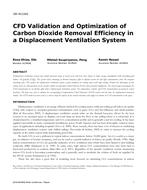Description
Displacement ventilation systems have found increased usage in recent years and have been shown to reduce energy consumption while providing good Indoor Air Quality (IAQ). The system takes advantage of thermal buoyancy effect to displace warm air and light containments above the occupant breathing zone. This makes the displacement ventilation system a good candidate for cooling spaces with high ceilings. Despite the advantages of this system, there are still questions on the system’s ability in removing Carbon Dioxide (CO2) and associated bioeffluents. The current paper investigates the CO2 concentration in an interior office with a displacement ventilation system. The temperature, velocity, and CO2 concentrations measured in several locations. The data was used to validate the corresponding Computational Fluid Dynamics (CFD) results and fine-tune the implemented numerical models. The CFD model was then used as a tool to study the impact of the exhaust locations and supply air volume on CO2 concentration in the space.
Citation: 2016 Winter Conference, Orlando, FL, Conference Papers
Product Details
- Published:
- 2015
- Number of Pages:
- 8
- Units of Measure:
- Dual
- File Size:
- 1 file , 810 KB
- Product Code(s):
- D-OR-16-C003




